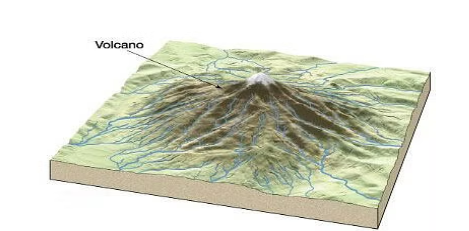Origin-and-evolution-of-universe-solar-system-and-earth / Origin and Evolution of Universe Solar System and Earth / Drainage Patterns
- Drainage patterns are categorised based on their distinctive forms, which are influenced by various factors, including local topography and underlying geology.
- These patterns evolve as a result of natural processes, determining the flow and distribution of water across the landscape.
- The creation of drainage channels is primarily attributed to increased surface runoff and the erosion of soil materials that offer the least resistance.
- Different types of drainage patterns, such as dendritic, trellis, radial, rectangular, and parallel, emerge based on the specific conditions in an area.
- Understanding the drainage patterns in an area provides valuable insights into the underlying geology and the history of the landscape, aiding in land management, urban planning, and environmental assessment.
TYPES OF DRAINAGE PATTERN
- DISCORDANT DRAINAGE PATTERN
- CONCORDANT DRAINAGE PATTERN
DISCORDANT DRAINAGE PATTERN
In discordant drainage patterns, the river's flow direction remains consistent despite alterations in the local topography. This pattern typically occurs when rivers maintain their course even as the landscape around them undergoes changes, such as uplift, faulting, or folding.
The discordant pattern is often categorised into two main types:
- Antecedent Drainage: This refers to rivers that maintain their courses while tectonic activity or uplift alters the land's topography. Essentially, the river's path predates the landscape changes. As the land changes due to uplift or other geological activities, the river continues to flow along its existing course, leading to a discordant pattern.
- Superimposed Drainage: In this scenario, a river maintains its course, ignoring the varying layers or geological structures beneath it. This type of drainage pattern results from a river's initial flow, which formed prior to the deposition of the existing surface materials.
CONCORDANT DRAINAGE PATTERN
Drainage patterns are intricately linked to an area's topography and geological characteristics, affecting how rivers follow their courses.
Drainage systems are commonly categorised based on their patterns, which can indicate the underlying landscape features.
Two primary drainage patterns include:
- Consequent Drainage: Consequent rivers flow in a pattern directly influenced by the existing slope and topographic features. They follow a course that is primarily determined by the terrain's original slope. As the landscape features change, rivers adapt their path according to the direction of maximum slope or least resistance.
- Subsequent Drainage: These rivers, shaped by geological characteristics, establish their courses following patterns resulting from the underlying rock structures. The rivers' direction and courses are guided by these geological features, such as varying layers of rocks, faults, or folds, influencing the path of the river.
Following are the types of drainage patterns seen in subsequent and Consequent drainage systems:
DENDRITIC DRAINAGE PATTERN
- The dendritic drainage pattern resembles the branching of tree limbs or roots, developing in regions where the underlying geological composition is relatively uniform, allowing rivers to branch out in a similar manner.
- The key aspect is the uniform lithology, where the lack of significant faulting and jointing results in a landscape that permits branching or ramification of drainage channels, forming a dendritic pattern.
- Rivers exhibiting this pattern, such as the Indus, Godavari, Mahanadi, Cauvery, and Krishna, illustrate this type of drainage system.

TRELLIS DRAINAGE PATTERN
- The trellis drainage pattern occurs in folded terrains where there's a juxtaposition of hard and soft rocks running parallel to each other.
- This geological setup typically occurs in areas where sedimentary rock formations are folded or inclined, allowing erosion to impact rocks of varying strength differently.
- As a result, rivers flow along the valleys created by these synclines, forming the primary course.
- The pattern manifests when the primary tributaries of major rivers flow in a parallel fashion, with smaller streams meeting them perpendicularly.
- The distinctive characteristic is the perpendicular connection of smaller streams to the main stream.
- Rivers in the upper reaches of the Himalayan region, such as the Indus, Ganga, and Brahmaputra, exhibit this trellis drainage pattern.

RADIAL DRAINAGE PATTERN
- The radial drainage pattern emanates from a central high point, often observed around conically shaped landforms such as volcanoes or elevated topographical points.
- It is aptly named 'radial' due to rivers originating from a central hill or summit and flowing outward in all directions.
- In the case of rivers like the Narmada and Son, tributaries of the Ganga, which flow from the Amarkantak range, this radial pattern is notably observed.

RECTANGULAR DRAINAGE PATTERN
- This particular drainage pattern showcases streams joining the main river at right angles, producing a network of rectangular patterns.
- These patterns result from subsequent processes in the landscape.
- One example of such a pattern can be observed in the Colorado River in the United States, while similar patterns can also be found in streams in the Vindhyan Mountains of India.


